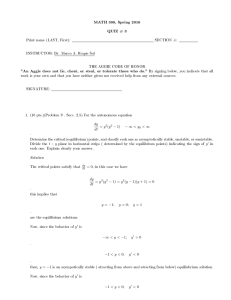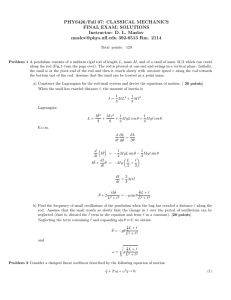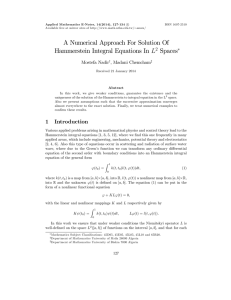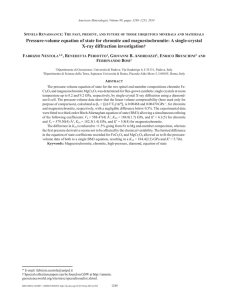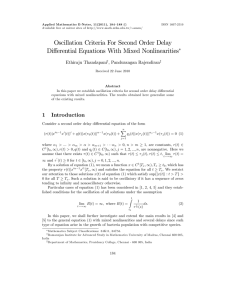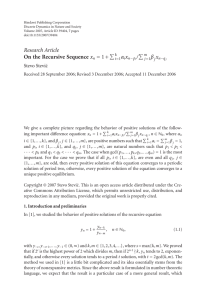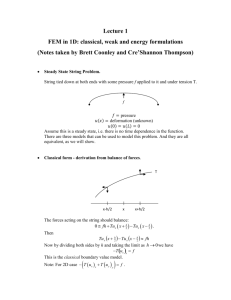第二章定常不可压势流的数值计算Chapter 2 Numerical computation
advertisement
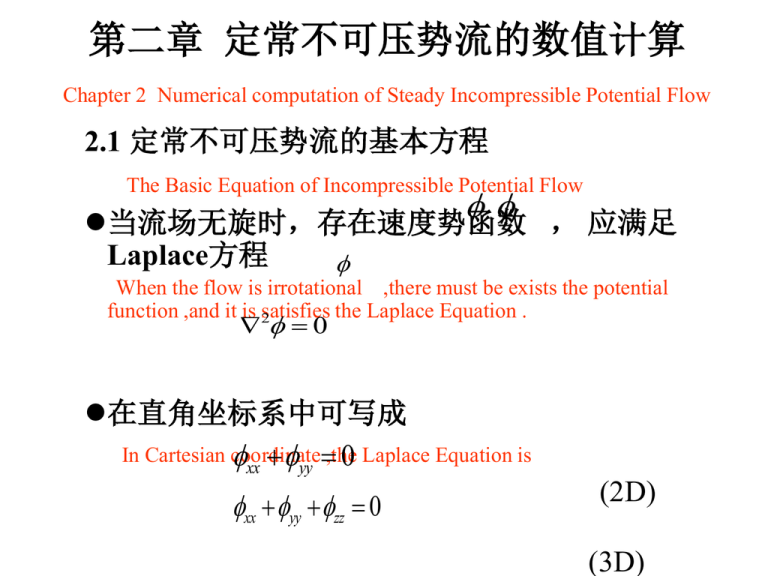
第二章 定常不可压势流的数值计算 Chapter 2 Numerical computation of Steady Incompressible Potential Flow 2.1 定常不可压势流的基本方程 The Basic Equation of Incompressible Potential Flow 当流场无旋时,存在速度势函数 , 应满足 Laplace方程 When the flow is irrotational ,there must be exists the potential function ,and it is 2satisfies the Laplace Equation . 0 在直角坐标系中可写成 In Cartesian coordinate xx yy ,the0 Laplace Equation is xx yy zz 0 (2D) (3D) 在柱坐标系中 In cylindrical coordinate ,it is 2 1 1 2 2 0 (二维轴对称) 2 2 r r r r 2 1 1 2 2 2 2 0 (三维) 2 2 r r r r z V p 计算出 ,即可得到 和 V , V 2 V V After gained ,the velocity and pressure can be obtained as follow 1 p v 2 p const 2 若流场中有源或者汇,则 If there exist a source or sink in the flow ,then V q, 即 2 Q The equation becomes xx yy (zz ) Q 2.2 由分布的源,汇引起的径向流动计算 The computation of the flow introduced by the distributed source and sink . 假设流场中源的分布(平面问题), r0 r 4r0 Assume: the distribution of the source and sink is r (r0 , 4r0 ] following r cycle regime the field within a q q0 , 0 r0 则PDE为 1 r rr r q0 r Therefore the PDE is r0 无量纲化参数 choose the dimensionless parameters as follows, Ur r R , ,U r0 r0V0 U0 无量纲方程 the dimensionless equation becomes d 1 d ( 2 ) dR dR R dR q0 r0 / v0 1 R 4 流场区域 1 R 4 Flow field regained is limited as 此方程为二阶线性齐次方程,存在精确解 This eq is a two order linear equation ,it 0has a accurate 1 solution R 3 ln R 9, 24 9 对于 则,精确解为 The accurate solution is R3 24ln R 对应的方程阶为 The corresponding PDE is RR 1 R 9R R 边界条件 R=1时1 64 24 ln 4 B.C R=4 时 速度解 24 The solution of U velocity 2 2R R 下面讨论其数值解The numerical value solution will be discussed as following 一般线性二项齐次常微分方程边值问题: In general case , the 2D liner PDE can be written in to express f x ,f xx using centeral difference scheme, which has 2 order accuracy. f xx A( x) f x B( x) f D( x) xmin x xmax 将方程中 fx 和 f xx 用中心差分格式表示(具有二阶精度) 1 f x f i ( f i 1 f i 1 ) 2h 1 f i 2 ( f i 1 2 f i f i 1 ) h 微分方程可化为差分方程: Then ,the PDE can be written into FDE form. i 1 h fi i h f i 1 i 1 x f i 1 Ai 1 ( f 2 f f ) ( fi 1 fi 1 ) Bi fi Di i 1 i i 1 2 h 2h That is Ci1 fi 1 Ci 2 fi Ci 3 fi 1 Ci 4 其中: where h Ci1 1 Ai 2 Ci 2 2 h2 Bi h Ci 3 1 Ai 2 Ci 4 h2 Di 对于n各节点(i=1,2,3,……n),上式构成一个线性方程 组,可写为一个三对角矩阵 For node number n , the series equations can be written as a linear equations, also can be express as a triangle array as following. C11 C12 0 C21 0 0 ... ... 0 0 0 0 0 0 0 0 C22 C23 0 0 0 C13 0 0 C31 C32 C33 ... ... ... ... ... 0 0 C n1 ,1 Cn1,2 Cn1,3 0 0 0 Cn1 Cn 2 0 f1 C14 0 f 2 C24 0 f3 C34 ... ... ... 0 f n1 Cn1,4 Cn3 f n Cn 4 此线性方程组可用追赶法求解,也可用高斯法求解,还可 以采用迭代法求解 This linear equations can be solved using gauss method ,or Saidel iterative method 对于源汇问题: For above distributed source problem A( R) 1/ R B( R) 0 Rmin 1 R max 4 D( R) 9R 可以求出:The potential function can be solved ,and the velocity can be calculated . i (i=1,2,3,……n) i 1 i 1 ui 2h 作业:用书上的程序计算出数值解,并与精确解进行比较。 Question : using the fortran program provided in the text book (in p13) to get the numerical solution ,and compare the results with the accuracy solution. 2.3旋转体绕流的数值解法(源、汇、偶极子) Numerical method for a Rotational Body Flow (source , sink and doublets) 用点源(汇)分布在对称轴上来模拟流体绕过任意旋 转体 Source and sink are used to simulate the flow past a rotational body. 轴对称不可压流动流函数方程为: The steam function equation for axis-symmetric flow is : 2 1 2 2 0 2 Z r r r 该方程是线性方程,其通解为: It is a linear PDE , and the general solution is (r, z) c ln r z 2 2 上式代表点源 It denotes a flow introduced by a source. qj 可以用基本解叠加构成绕旋转体的解。 采用在Z轴上分布的源 ,使这些点源在物体表面各点的 扰动速度与自由来流叠加后在 法线方向都为0. To distribute source and sink on the axis of the body and let the normal component of velocity on body surface zero. d 各点处线源的流函数为 q j d The stream function d ofthe line source element on r (z ) 2 2 Z Z 其中q j 为源的线密度线元 函数 : j j 1 和 上的源流 Z stream function on linear source from j Z j 1 to Z J 1 r j d q j [ r 2 ( z z j 1 )2 r 2 ( z z j )2 ] Z j P(zi,ri) d(zj, rj) d(zj+1,rj+1) P(zj, rj) d Z 把AB分成n段,其总的流函数为: divide AB into n segments and the stream function is : 1 (r , z ) Ur q [ r ( z z ) r ( z z ) ] 2 n 2 2 j 1 j j 1 2 2 2 j (ri , zi ) 在旋转体子午线上任意一点 上的流函 n 1 2 数为: (ri , zi ) Ur q j [ ri 2 ( zi z j 1 )2 ri 2 ( zi z j )2 ] 2 j 1 for a point on the surface the stream function is : (ri , zi ) Since (ri , zi ) 是一条流线上的点,通常称为零流线 is on the surface ,it is defined as zero streamline 表面为零流 线 (ri , zi ) 0 1 2 n Uri q j [ ri 2 ( zi z j 1 )2 ri 2 ( zi z j )2 ] 0 2 i 1 QJ q j / U • 令 , d j di , j di , j 1 则 then n 1 2 d Q ri j J 2 j 1 Q Q 上式是关于 的线性方程组,同时,要使 的总和为0,即 which denotes a Qlinear J J J equations about ,and the total net volume 总源强为 零 so: flax inside the body must be zero, S Q 0 n j 1 j J (ri , zi ) 在物面上其n-1个点 ,构成n-1组线性 方程,再加上面的方程即可构成线性方程: n-1 points on surface and above equation construct a closed linear equations as following: 1 2 n d j QJ 2 ri (i 1, 2,......, n 1) j 1 n S Q 0 j J j 1 QJ 求解此方程可得到 和 qj QJ ,从而得到流线数解 solving this equation ,the source can be got . 1 2 n Ur q j [ r 2 ( z z j 1 )2 r 2 ( z z j )2 ] 2 j 1 n 1 1 Vx U 1 Q j [ ] y r 2 ( z z j 1 ) 2 r 2 ( z z j ) 2 j 1 n z z j 1 z z j UQJ [ ] Vy 2 2 2 2 x r j 1 r ( z z j 1 ) r ( z z j ) 利用伯努利方程可得: Using Bernoulli equation , then 1 1 2 p p U (Vx2 Vy2 ) 2 2 Vr 2 Vz 2 Cp 1 ( ) ( ) U U §2.4 椭圆型偏微分方程的数值解 Numerical solution of the ellipse PPE 二阶偏微分方程的一般形式 General form of 2nd order PPE af xx+bf xy +cfyy=F(x,y,z,f,fx,fy) ●具有三种可能的类型 It can be three following types (1)椭圆型(方程),当 b2-4ac<0 Ellipse, when (2)抛物型(方程),当 b2-4ac=0 Parabola ,when (3)双曲型(方程),当 b2-4ac>0 Hyperbola when 以泊松方程为例说明椭圆型方程的数值解法 b2-4ac=04*1*1<0 To explain the numerical solution using a Possion equation f x x + f y y=q (x , y) 用i代表x方向节点序号 i denote the sequence where in x direction j代表y方向节点序号 j denote the sequence where in y direction 左边界(1, j) left 右边界(m, j) Right 内点 (i, j) inner (1<i<m) 上边界点(i, n)(i=1,2…,m) 2D Possion equation Up boundary 下边界点(i, 1)(i=1,2…,m) Low boundary 内点 (i, j)(i=2,3…,m-1,j=2,3, …,n-1) Inner point 将Possion 方程写成差分方程 To write the Possion equation into FDE 1 1 ( f 2 f f ) ( f i , j 1 2 f i , j f i , j 1 ) qi , j i 1, j i, j i 1, j 2 2 (x) (y) 若△x= △y=h,则上式可解为 Give △x= △y=h,then 1 1 2 f ij ( f i 1, j f i 1, j f i , j 1 f i , j 1 ) h qij 4 4 Laplace调和函数的平均值定理 Average of the Laplace function 此式在给定边界值时构成一个(m-2)*(n-2)阶的代数方程 组。可以用多种方法。 When the boundary value is known, it constructs a (m-2)*(n-2)order linear equations 直接法direct method 矩阵求逆 Array LU分解 decompose 迭代法 iterative method 前三种方法要求的计算内存和计算时间长 The first three methods ned more memory and CPU time 迭代法:对计算机资源要求低(逐点迭代) Iteration method requires less resource of computer 1 ( n1) 1 2 ( n) ( n1) ( n) f ij ( f i1, j f i1, j f i , j 1 f i , j 1 ) h qij 4 4 (i=2,3,4,.....,m-1,j=2,3,4,.....,n-1) ( n1) 每一点都同周围四点的最新值平均和当前点的原项值求解 Value on every points is the average of surroundings ( n) f 可以证明,当 n→ 时 , i , j 将接近有限差分 方程的解 f i , j , f ( n)i , j will approach the DE solution. It is proved that when n→ ei(,nj) f (n) i, j fi , j 1 (n) (ei 1, j ei(n1,) j ei(,nj)1 ei(,nj)1 ) 4 1 ( n) ( n 1) ei , j ei 1, j ei(n1,) j ei(,nj)1 ei(,nj)1 4 ei(,nj) 1 1 (N ( nM n 1 ) ) E E 14MM 1( 4 N N (0) ( 0 ) )E E 当节点数比较多时,迭代收敛很慢 When the number of node is large convergence will be slowly 超松弛迭代: Super-Relaxation iteration 把迭代计算结果作为中间值, The iterativation solution is give as median (n0.5) 1 ( f ( n1) f ( n1) f ( n) f ( n) ) h2 q i 1, j i , j 1 i , j 1 i 1, j i, j f 4 将 f i (, nj ) 与 1 (n ) fi , j 2 进行加权平均得到 The wrighted average of the fi (, nj ) (n f i (, nj 1) wf i , j and 1 ) 2 1 (n ) fi , j 2 (1 w) f i (, nj ) 或写成:or 1 (n ) fi(, nj 1) w( fi , j 2 fi(, nj ) ) fi(, nj ) fi(, nj ) w fi , j (w 0,0 w 2) 把两次迭代得到的差别(利用松弛因子对修正量进行放 大或缩小) To apply the difference between the cuidial and calculated value 当 0 w 1 时为弱松弛 When 0 w 1 it is so called weak relaxation 当 1 w When 1 2 时为超松弛 w 2 it is so called weak relaxation 最佳超松弛因子 Optical best value of the Relaxation factor wopt 8 4 4 2 2 cos m cos n 例:不可压平面流通过二维容器(如图) Example 2D incompressible flow in a conduct y 0 2 2 x y 2 2 n=17 差分方程的迭代公式 iteration of the equation formula w i , j (1 w) i , j i1, j i1, j i , j1 i , j1 4 边界条件: he 0 BC 1 0 在 AB 线上 on AB A B m 在其余边界上 on other B 容器的进口的体积流量为AB线上的任意一点与其表面上点的连线上 的体积流量为1 x 小 结 • 本章内容(contents) 定常不可压势流差分方法(FDM of elliptic PDE for steady incompressible potential flow) 定常不可压势流源汇法(Source and sink method for axissymmetric incompressible flow) 椭圆型偏微分方程数值方法(Numerical method for elliptic PDEs) 本章重点(focus) 椭圆型偏微分方程数值方法(Numerical method for elliptic DEs)



